|
Issue Contents :: Feature :: Project Winter Term :: [ 1 2 3 4 ]
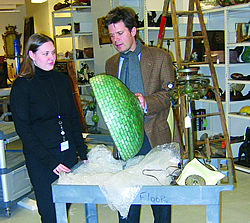 Internship at Sotheby’s, New York City Internship at Sotheby’s, New York City
Megan Whitman, senior art history
and German studies major
A valuable part of my internship was learning directly from the experts. My internship fell under the supervision of James Zemaitis ’91, senior vice president and director of Sotheby’s 20th-Century Design Department.
I had the chance to examine a lamp that had been passed off as an original Louis Comfort Tiffany lamp. I was shown the original Tiffany lamp alongside the fake and taught the subtle differences between the two. I also spent time researching Daum objects to determine their appropriate estimates for an upcoming auction. I photographed objects for study and oversaw the reorganization of the department’s extensive library.
I spent a fair amount of time in Sotheby’s warehouse, which gave me much exposure to Tiffany and Daum lamps, as well as other objects by such designers as Lalique, Emile Gallé, Edgar Brandt, and Rembrandt Bugatti.
As my career interest involves arts management and administration, I appreciated learning how art specialists work cooperatively with conservators, cataloguers, designers, patrons, and others toward the realization of an auction. I was able to assist the professionals through participation, rather than observation.
Above: Whitman examines a lamp with Sotheby’s James Zemaitis ’91
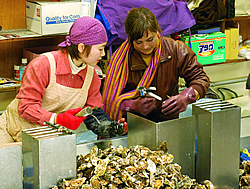 Land-use study in Japan Land-use study in Japan
Lee Hislop, junior biology major
I traveled to Japan with a group of students, led by Professor of Biology David Benzing, to explore such environmental issues as the country’s aging population and its lack of flat land for crop cultivation. We visited water and sewage treatment plants in Tokyo, geothermal and nuclear energy plants, an ocean energy research institute, and a large solar ark built recently by the SANYO corporation. We learned about urban planning at Obirin University and visited seaweed and oyster farms.
The most interesting sites to me were the two farms we visited in Kyushu. The first was a one-man operation in the mountains. Rice is the main crop, supplemented with several citrus trees. The farmer uses insects found in the rice paddies as a way of judging the overall health of his crop. He also uses ducks to control weeds, utilizing their natural taste for weeds over rice plants. The ducks provided an excellent source of organic fertilizer and were used for profit. Chickens were raised for their waste products, and compost from excess brush was also used. These techniques allow this farmer to forgo the use of any pesticides or chemical fertilizers.
The second farm was one of more than 200 that belong to the Japanese Agricultural Association. This co-op charges member farmers 15 percent of their profits and in return provides loans, equipment, fertilizers, and pesticides, plus transport of crops to wholesale auctions. This farm was larger and relied on greenhouses; it even had mechanical sorters for the tomato and melon crops. The farm seemed more like a factory, but the techniques used didn’t ignore the environment—a large part of their method involved soil science. In addition, this farm didn’t employ the common practice of calendar sprayings of pesticides; rather, pesticides are used only when there is a serious threat of herbivory.
I am interested in agriculture as a profession. This project helped me see that the task we face is making sustainability profitable and convincing people that it’s worth more than any amount of money.
Above Sophomore Cara Kritikos (right) cleans mussels.
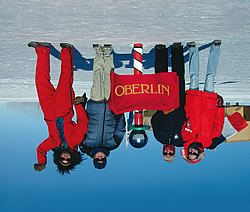 Research in atmospheric physics, South Pole Research in atmospheric physics, South Pole
Susannah Burrows, senior physics
and German studies major
I spent about 12 days working with Assistant Professor of Physics Chris Martin at the South Pole, in a research project funded by a grant from the National Science Foundation.
We used the Antarctic Submillimeter Telescope and Remote Observatory (AST/RO) to measure radiation emitted by carbon monoxide in the middle part of the atmosphere. Carbon monoxide is toxic to humans and exists primarily as a pollutant near the earth’s surface, but it occurs naturally at higher altitudes in measurable concentrations. From our data, we can determine wind speeds and atmospheric concentrations of CO. The research could be used to test the predictions of climate models or validate satellite measurements.
We also observed other molecules. During our observing period, a strong geomagnetic storm occurred. Our data during this period seem to indicate strong upper atmospheric heating related to the storm.
This project was part of my honors project in atmospheric physics, an area which I hope to pursue further in graduate studies. Understanding the earth’s climate systems is becoming increasingly vital as the evidence for climate change grows. I’m interested in improving our knowledge of the atmosphere so we can more accurately predict how human actions and natural events might affect the global climate.
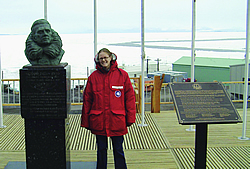 Aside from the academic aspects, this was a unique chance to travel to a part of the world that very few people will ever visit. I got to watch the sun spiral in 24-hour circles around the sky, experience a wind chill of minus-45 degrees, travel in an LC-130 Hercules (an Air Force plane), and visit the Discovery hut erected by Robert Falcon Scott during his 1902 Antarctic expedition. Aside from the academic aspects, this was a unique chance to travel to a part of the world that very few people will ever visit. I got to watch the sun spiral in 24-hour circles around the sky, experience a wind chill of minus-45 degrees, travel in an LC-130 Hercules (an Air Force plane), and visit the Discovery hut erected by Robert Falcon Scott during his 1902 Antarctic expedition.
I met fascinating people, from construction workers building the new South Pole station to scientists from around the world conducting polar research. I attended the second South Pole International Film Festival, which included 17 submissions all filmed in whole or in part at the South Pole, by the people working and living there. It was an experience I will never forget.
Left: Burrows at the Richard E. Byrd memorial. Above: Obies at the ceremonial South Pole include Susannah Burrows '05, Katie Hess '00, Assistant Professor of Physics Chris Martin, and Josiah Adams '02.
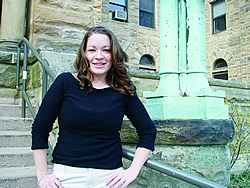 Research and production intern, ABC News’ Law and
Justice Unit, New York City Research and production intern, ABC News’ Law and
Justice Unit, New York City
Gabrielle Brown, senior English, law and society, and gender and women’s studies major
My tasks included working with TV producers and interns in researching and compiling information for segments on Good Morning America, 20/20, World News Tonight, Nightline, World News Now, and Primetime Live. Although I worked on a vast array of stories at all stages, much of my work was centered around two major long-running stories. In each, I witnessed the growth of a news story from its initial idea through its televised production.
Because everyone in the unit has a law degree, and because the focus of the unit is on the legal aspects of the news stories, I was able to see a side of the law beyond the legal briefs, offices, and courtrooms to which I’d previously been exposed. My experience was intensified by the chance to shadow the producers as they worked with the editors and television correspondents.
Working in such a face-paced environment allowed me to witness the importance of deadlines, speed, and precision. It was such an exciting experience, particularly waking up in the mornings or coming home at night to see the work I’d done being televised.
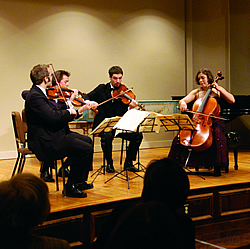 Concert at the Smithsonian Museum of American History Concert at the Smithsonian Museum of American History
Evan Few, senior violin performance and
historical performance major
As the second violinist of Oberlin’s Jasper String Quartet, I traveled to DC, where we performed on a rare quartet of instruments by J.B. Vuillaume in the Smithsonian’s Hall of Musical Instruments. We also visited six DC-area schools to familiarize students with the sounds of a classical string quartet and offer them a glimpse into our lives as young musicians.
The collection of Vuillaumes is very special. Although they weren’t crafted as a matched “quartet,” the tone quality and range of colors of the four instruments is so similar and the collective sound so perfectly suited for string quartet playing that we were able to look beyond the mere technical aspects of playing and focus on the music itself.
The highest point for me was the performance of the Adagio from the Mozart Quartet, K. 458. During this slow movement, I felt we tapped into something incredibly intimate and new. When you can step out of the way of an instrument, as we could, the possibility for real inspiration and performing “in the moment” truly opens up.
Above: J Freivogel, Evan Few, Sam Quintal, and Rachel Henderson perform at the Hall of Musical Instruments in DC.
Next Page >>
|





